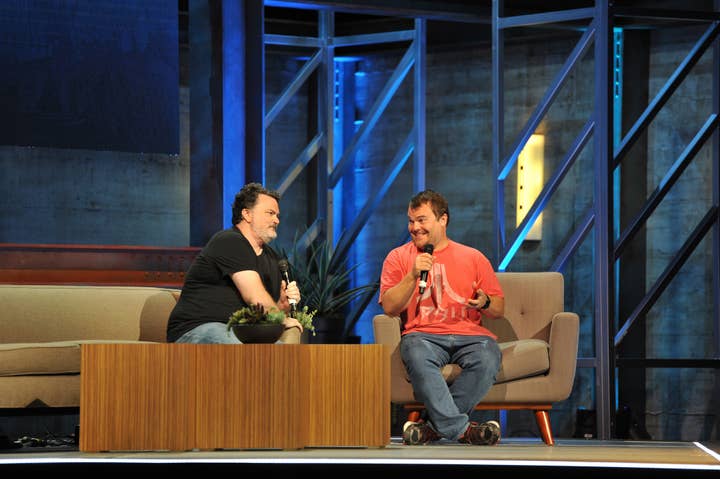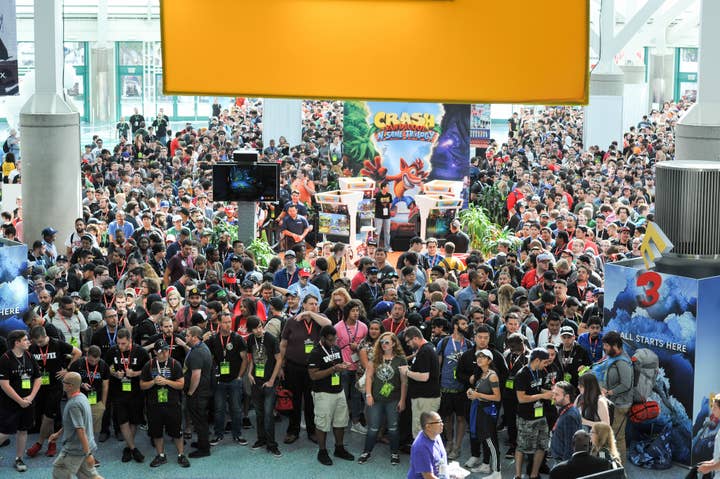ESA ponders E3's future
More consumers? A different venue? The Gamescom model?
E3 2017 was always going to be a challenge.
Before the show, it felt that industry representatives were determined to dislike the consumer attendance no matter what. And after the hectic, confusing and crowded first day, you began to fear that the organisers - US trade body ESA - had got it wrong.
Yet teething problems were inevitable, and by days two and three, the show had regulated itself. Booths had discovered how to manage the onslaught of fans, business still got done, and social media was buzzing.
But where does E3 go from here? The ESA insist that it makes no big decisions on the next show until it's received the feedback from attendees. However, the expectation is that the firm will descend further down that consumer rabbit hole.
If that's the case, things may need to change. The Los Angeles Convention Center struggled at times to handle the almost 70,000 visitors - particularly the Nintendo and Xbox booths, which were swamped from the moment the doors opened.

Ahead of this year's show, GamesIndustry.biz took part in a media roundtable with Mike Gallagher, the president of the ESA. And the question we all wanted answering was this: with attendance expected to get bigger, is LA really the best place for the expo?
"We had a meeting with the City of Los Angeles just before the show, and we continue very good discussions with them," Gallagher said. "Their key partner is Anschutz Entertainment Group (AEG), which owns the building we are sitting in, along with the surrounding environment [the LA Live area that sits adjacent to the LACC]. As you can see from all the construction cranes, there is a lot of really good development that is happening, which is attractive to have the show remain in Los Angeles.
"The Convention Center needs to evolve, particularly if we are going to bring in consumers to the degree that we have this year"
"We have signed up to have the show this year, next year and then the following year is when we start to look at our options. We have been very clear with the City that the Convention Center needs to evolve, particularly if we are going to bring in consumers to the degree that we have this year.
"Because of the 15,000 consumers, we have added things like the Coliseum and esports to entertain them and give them something to do besides the booths. In order to add more of those elements, we need to have a footprint here in LA that can accommodate 15,000 - or more, depending how that goes in the future - consumers, in addition to all the business attendees from an industry that is growing rapidly. We are pretty much maxing out the footprint in terms of what we are using this year.
"Next year will be a critical decision year, and how the show performs this year will be key to that."

It may sound bleak for the City of Los Angeles, but Gallagher is actually bullish about the regeneration efforts that are planned.
"They have plans to revitalise the LACC," he explains. "Much of that is about adding square footage, and also making it more continuous. In other words, to have an easier flow between the two halls. That solves a lot of logistical challenges for us, it makes it easier for attendees and exhibitors, and there is just a variety of things that modernises it. Things like adding a ballroom would be fantastic.
"And you can see the investment in hotels that have gone on. The City will have doubled the number of hotels by 2018, which has been our No.1 focus, to make sure there is enough room for people to stay at diverse price points. We are optimistic, but the rubber will meet the road when we see those improvements happening, and that they do not negatively impact the show as they are unfolding. None of these things will take place quickly."
He continues: "The City says that by 2020 we'll have almost 500,000 square foot of exhibitor space. That gives us room for more exhibitors, more hands-on experiences and more attendance. In terms of allowing the flow of consumers, while also enabling business to be done, that is a major release valve. It needs to happen if we are going to continue on this trajectory. I've spoken before about the Goldilocks standard for E3. If you have too few people, that won't be a good show. If you overcook it and have too many, it won't be a good experience. Our answer is to have it just right. If we want to grow, we need the City to enable us to shape the show the way we want."
The consumer element is important to ESA. It opens up new business models, both in terms of tickets but also retail sales from the show floor. It also allows the trade body to satisfy the criticism of companies like EA, which decided not to attend E3 for a second consecutive year. EA's pre-E3 press conference was a clear sign that the publisher wants to see consumers spreading the messages about its games, and not just the traditional media.
"The most aggressive users of social media, the ones who voices really echo the longest and furthest, are the consumers themselves"
"Our business model has evolved to adapt to the fact that the most aggressive users of social media, the ones who voices really echo the longest and furthest, are the consumers themselves," Gallagher says.
However, the addition of consumers still did not persuade EA to come back.
"E3 is the place to launch your game," Gallagher insists. "It is the best place to be and we have the numbers to back that up. The exhibitors at E3 deliver outstanding metrics in terms of engagement.
"But it is incumbent on us. We need to work out how to make the show everything that exhibitors want it to be. The steps we are taking this year is adding 15,000 consumers, it is adding esports, it is adding the Coliseum. We are taking big strides. Our goal is to make the exhibitors who aren't coming this year to look at that and say: 'How do I get in next year?' And that is the conversations we will have after the show. Learn what went well, what we need to improve upon - and there will be plenty of that - and see if we can bring them back."
He continues: "EA knows it's very welcome. Its presence in LA, with the event they did, is clearly indicative of the incredible centre of gravity that E3 provides for the industry. You come to E3 to make announcements and speak to gamers at the one time of the year when they're all tuned in to the same frequency. It would be terrific if we could have them back, but that's a decision for them to make and we to earn."

For those of us in the media, the most noticeable thing about E3 2017 was how long it went on for. Pre-2015, E3's conferences took place on Monday, before Bethesda launched its Sunday night conference. This year, EA moved its event to Saturday, with Xbox also moved into Sunday. It spread the events out, but by the time E3 opened its doors properly, we'd almost done a full week of work.
"On the question of geography and time, there are limits to this," Gallagher acknowledges. "Certainly, we are at the very edge of what those should be. Especially when it comes to standard for the gamers, for the media and also for logistics - in terms of getting people from one place to another - and making sure that people can see what they need.
"We are working with the City to see if we can harmonise it so that we can have consumer days and business days"
"We are working with the Convention Center and AEG to develop more places that are more continuous. If we adjust the business model and if we continue to innovative for our exhibitors, then I believe we will be able to limit the footprint in time and place, to make it easier for everyone to navigate. But there are limits to how far this can go in terms of how far away the events can be, and still be relevant and continuous to the E3 experience. And also how long this show goes on for. We are feeling it this year."
Of course, in theory, the show could go on even longer if it adopted the Gamescom model. Although the LACC is arguably too small to split its floor space between business and consumers like you can at the European show, the ESA could extend the event into the weekend. It could keep the main week as the business days, and invite consumers along during the weekend. That sounds like a sensible solution, but that would make E3 go on even longer.
"Yes, absolutely we are looking at [the Gamescom model]," says Gallagher.
"If we could move this until where the consumer elements is at a weekend, it would enable us to better serve that experience. Unfortunately, the show dates that we have reserved here at LA... it takes so long to move this stuff in and out. Look at these booths, look at those production values... to get those in and out, to test it and make sure it works, it takes a lot of time. Then when it's done, it takes a long time to get it out. Because of that we can't get it done for a weekend. But we are working with the City to see if we can achieve this, and harmonise it so that we can have consumer days and business days at the show. But if you have a Friday, Saturday and Sunday as consumer days, you start backing up into the week when you can have some of these media briefings. So we need to have a footprint that allows us to consolidate some of those events in time."
Whatever the decision, it all suggests E3's consumer evolution is just beginning.
